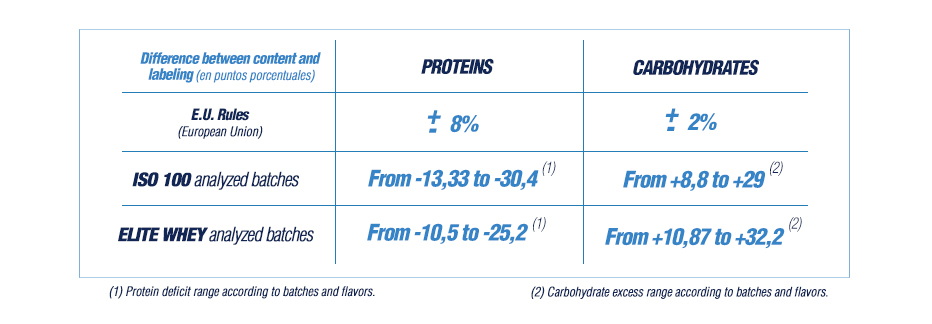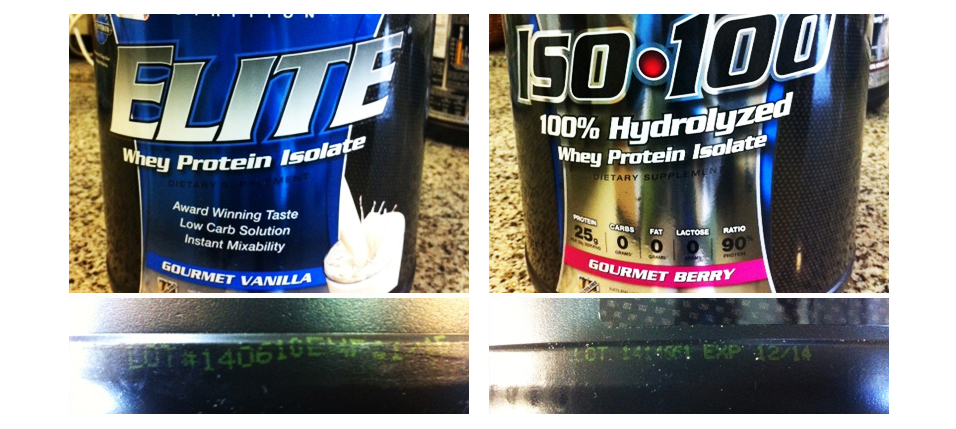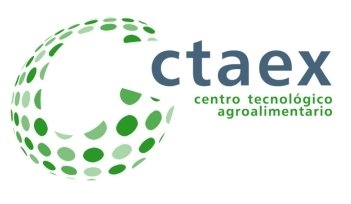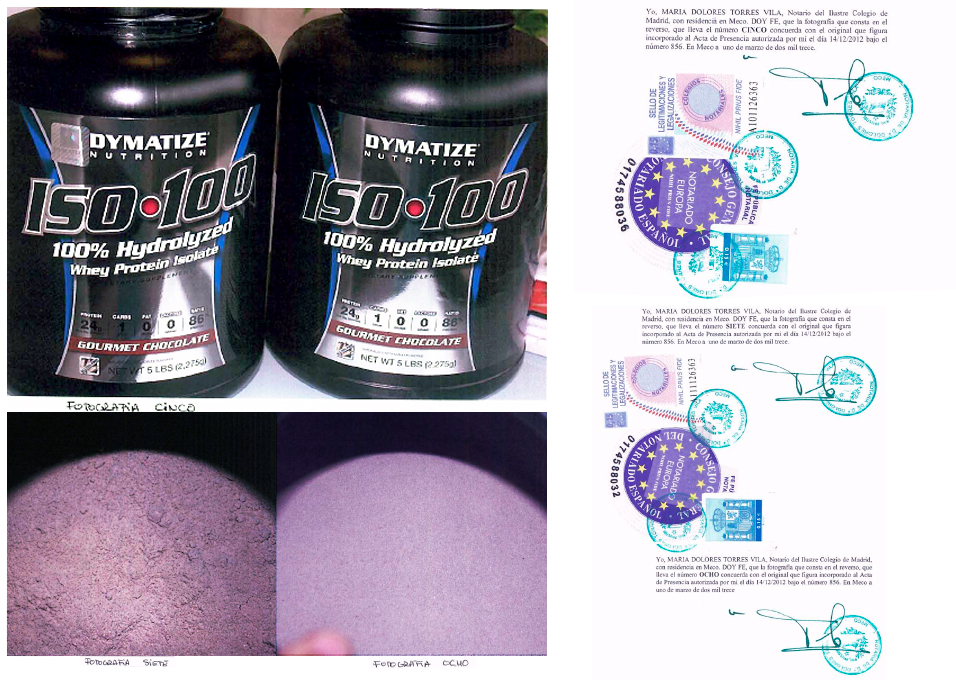This has turned out to be a counterfeiting issue in Europe. Customers outside of Europe will be fine, but we are not yet sure how to verify European tubs.
The rumor through the grapevine is that Dymatize claims the products tested below are European counterfeits and not their creation.
American samples have been sent for tests, and we should know the results in about a week. (May 14, 2013 Update - They passed!)
Until then, proceed with extreme caution and skepticism as you read through this post, especially if you are in North America, where we hope the products are still fine.

BEWARE: Possible Dymatize Protein European Counterfeiting Inside!
If you've ever bought Dymatize ISO-100 or Dymatize Elite Whey in Europe, we may have some bad news for you:
There's a possible chance that you're not getting what you bargained for.
Over the past month, reports have been surfacing that European Dymatize products have been consistently failing lab tests.
By "failing", we mean that in Europe, the above two products have been shown to contain less protein and far more carbohydrates than stated on the label.
In this post, we've researched and combined all available information. We do our best to give Dymatize the benefit of the doubt. At the moment, this seems to be a European counterfeit issue.
The evidence is certainly not bulletproof - there are still several unknowns, and they are all addressed lower down. While we do not want you to overreact, we do want you to be cautious when using these products if you are on an extremely tight diet or are in Europe.
Dymatize ISO-100 – Deals and Price Drop Alerts
Get Price Alerts
No spam, no scams.
Disclosure: PricePlow relies on pricing from stores with which we have a business relationship. We work hard to keep pricing current, but you may find a better offer.
Posts are sponsored in part by the retailers and/or brands listed on this page.
What We Know
In March of 2013, Spanish supplement retailer "MiGimnasio" published lab tests on Dymatize Elite Whey 5 lbs (rich chocolate flavor) and Dymatize ISO-100 5lbs (smooth banana flavor), demonstrating the following numbers:
Dymatize Elite Whey - Rich Chocolate - Lot 1550016 (Mfg in 03/2012)
| Nutrient | Expected | Actual |
|---|---|---|
| Protein | 24 | 22.39 |
| Carbs | 2 | 9.24! |
| Fat | 2 | 0.8 |
It's important to note that measurement was done on a 34.2g serving, while a scoop of rich chocolate flavor should be 31g.
Since those numbers are a touch skewed here in relation to the scoop, it's best to compare percentages of the macros. And this is where the alarms really get sounded:
The Percentage Breakdown
When you bought Elite Whey...
- You were expecting 74% of your tub to be protein, and 7.5% to be carbs.
- Instead, this tub gave 65.47% protein, and a whopping 27.03% in carbs!
Obviously, a serious disappointment.
As an added note, there was an additional 1.74g of ash and 5.67% humidity. These things will happen, although you hope to not eat that much ash in your shake.
Nearly 2g of ash just seems wrong. So wrong that this couldn't have possibly been done under Dymatize's direction, could it have?
Dymatize ISO-100 - Smooth Banana - Lot 1563991 (Mfg in 6/2012)
| Nutrient | Expected | Actual |
|---|---|---|
| Protein | 25 | 20.7 |
| Carbs | 0 | 6.42! |
| Fat | 0 | 0.13 |
In terms of percentages, this tubs gave 71.92% protein instead of 89%, and a tub of 22.99% carbs, in which you thought there were none (or extremely negligible amounts).*
Does this Fall within a Reasonable Margin of Error?
Nobody expects a product sold to the mass public to be perfect. Not even the FDA or the EU.
That said, the numbers are pretty tight. According to EU regulations, there's a permissible 8% protein difference allowed (plus or minus), and a far tighter 2% (+/-) for Carbs (source needed).
So, in the case of 10% error, Dymatize Elite Whey is actually within legal margin, while ISO-100 is not. Either way, it hardly matters - other tests shown below did fail in the protein department, and it's the gross mis-reporting of carbohydrates that is the true crime here, in our opinions.
Update: Below is an image provided by MiGimnasio.com, which covers their entire scope of measurements of a total of 12 tests (6 of each product), which we provide links to lower down:

Image courtesy MiGimnasio.com. Americans: the comma represents a decimal point.
Hey, Maybe it Was Just One Batch!!
That's what MiGimnasio's users said as well. It could have just been a couple of bad batches. They both came from the same distributor, so maybe they were to blame.
Not quite the case.
They went and received TEN more batches, from three different distributors, so now there are twelve tests, 6 on ISO-100, 6 on Elite Whey. All similar failures.
12 tests total, various lots, manufacturing dates, expiration dates, and flavors.
All Failures in the EU, while a whopping 3 out of 12 have "acceptable" protein numbers in the US -- and those numbers are just by the skin of their teeth.
The Problem with These Samples - Variability
The biggest issue with these samples is that they are extremely, and drastically all different. It adds suspicion to the fact that amateur counterfeiting was done somewhere in Europe.
If Dymatize was purposely doing this, which seems more and more unlikely as time goes on, it would have been done in a careful and controlled manner, wouldn't it?
You've heard of something being "too good to be true". This seems like the opposite -- too bad to be true.
(Contact us if these links stop working - we can post mirrors).
The Critical Skepticism: What We Don't Know
Here are the biggest questions we have, and each one is hugely important:
- How were these tested?
- What methods were used?
- What instrumentation?
- Was that instrumentation in calibration?
- How were the 100g samples chosen and mixed?
- How many re-tests per tub?
- How can we be certain that these weren't counterfeit? Is Dymatize really to blame?
- What about American samples?
We discuss the lab used lower down, and have already asked them these questions. If you'd like to stay up to date on the results, sign up for notifications below:
Maybe they just pulled their samples from the top of the container, where the carbs magically "floated to the top"!
Maybe the Tests Were Bad!
Maybe. And this is a major reason why we're not yet ready to throw Dymatize into the fire - we do not currently know answers to the questions above, and they may not be the ones truly responsible for the problems.
There are several ways to measure the various amounts of macronutrients in a given substance, and each type has its issues. Some forms of measurement are downright inaccurate, while others are far more trustworthy.
Until we know what type of testing was done here, we cannot be 100% sure that this is 100% accurate.
But it's not really the protein number we're livid about. It's the carbohydrate number -- a measurement which, even with a reasonable amount of error factored in, is still grossly unacceptable.
Which leads us to the next section:
Who Ran These Tests?
The tests were performed by ctaex (Centro Tecnológico Agroalimentario Extremadura), a Spanish lab near the border of Portugal with an assortment of measurement capabilities.
So, with regards to the questions I have above, I've asked these questions to CTAEX (translated to Spanish). I am also dropping them a Tweet and Facebook message to please respond to this email.
As someone who used to work for an instrumentation measurement company, I understand the critical importance of rigorous calibration of measurement equipment. Similar to the "chain of custody" of the protein products (discussed below), there is also a "calibration chain" which shows a path between NIST's standards of measurement and the tools used to calibrate the equipment. The longer this chain, the more measurement error is introduced.
This is the field of science known as "metrology", which is a critically important, yet mostly-unknown and unheralded field.
Until I get a response, I will not be 100% confident in any findings. We will update this post if and when we get a response, so you can sign up for notifications through our newsletter.
Maybe That Lab is a Protein "Grinch"
Another possibility, until you see a ton of other tests ordered by MiGimnasio at ctaex, all of which either met or exceeded label claims for protein:
These guys didn't have many problems with ctaex.... and there are others. Again, many of these products have more protein than expected!
So we don't think the lab is the problem. Instead, we think it's the distribution chain, or the sourcing.
What was the Chain of Custody?
Another important thing is that you need a validated "chain of custody"[1] on an unopened container that proves the path that the product took to get from the manufacturer to the lab.
For instance, if Billy Bob buys a tub at GNC, throws it in the back of his truck, and then gets it tested, there isn't exactly a proven, unbroken chain of custody that certifies it hasn't been messed with. For all we know, Billy Bob works for the competitor, or his dog bit the tub.
The Distributors Used:
In the case of these batches, they were supposedly originally supplied by Osuna Sport SL, a company headquartered in Granada, Spain. They are one of Dymatize's official distributors in Spain.
However, the new batches measured on April 16th were then supplied to MiGimnasio.com by the following:
- European Sport Nutrition BV (ESN), Dymatize's official European distributor in the Netherlands
- Performance Atletica SL, based in Pozuelo de Alarcón (Madrid)
This now gives you three different distributors.
What if they were "fake" tubs. This Happens in Europe Sometimes!
Unfortunately, that is true. Driven Sports recently dealt with European fakes, and in this case, it actually seems extremely likely due to the American tests passing.
In this case, each container had the authenticity hologram that is supposedly placed by Performance Athletica SL.
You can see a portion of that hologram and the lot number printing, in the images below:

Images provied by the lab, CTAEX
I must state that this is not a valid chain of custody, since we don't have 100% of the paper trail to go with it. We have requested these documents, but it is albeit the weakest part of the investigation.
Perhaps the distributors have been "watering down the product" without Dymatize's knowledge. This is why we need to test American samples. May 14, 2013 Update: They passed!
Notarized Images of Inconsistent Tubs
Another thing found to be extremely suspect was the fact that different batches of the same flavor of ISO-100 were not even close to having the same color or consistency.
Below is a notarized image of this, but the original PDF has even more images and is in far higher quality:
In case you needed it, here's a translation (provided by Google) of the Notary's stamp:
I, Maria Dolores Torres Vila, Notary of Madrid Bar, with residence in Meco. ATTEST that the picture that appears in the back, which bears the number ONE matches the original figure Presence incorporated into the Act authorized by me the day 14/12/2012 under the number 856. On March 1 Meco two thousand and thirteen.
Even if you're an American who distrusts all things non-American, this is food for thought. Spain is not some criminally run enterprise. It is a real country with real laws, just like your very own.
But perhaps MiGimnasio's founder (and/or one or more of these distributors) has a personal vendetta for Dymatize, and we've been sucked in to their drama. Which brings us to the next point:
This Has Happened Before... Kind Of
In 2007, a foreign competitor attacked Dymatize with similar claims. Much of it is documented here (26 page thread that I admittedly haven't read), with a 2008 posting response by the CEO here.
The difference is that this time, it's a retailer who actually makes money alongside Dymatize, and doesn't seem to be a competitor so much as a classy group of Spanish guys and gals.
This doesn't mean that someone at the sourcing end, or the European distribution end (May 14, 2013 Update: This is likely where the problem was), isn't screwing with Dymatize's operation somewhere during the process.
Maybe They're Only Doing this to Europeans
This is a major possibility too. There is a chance that we're okay in the US and Dymatize (or more likely, one of the distributing partners) only chose to scam in their turf overseas.
In fact, it's the most major possibility, and the point to hammer home. Until we have more information, Dymatize can't fully be to blame. Counterfeits happen.
However, what if they were knowingly gaming the European system? Would you really want to support a company that does that?
Silence is a Sign...
Since this drama began, there has not been a single peep from Dymatize.
In the discussion forums, right when it all started in March, one of their reps (who is clearly a soldier and not to blame), stated that he'd take it to the higher-ups and return with a response. He never returned.
This is likely due to the fact that everyone in the company has probably been "gagged" by a lawyer. Anything they say or do could, at this point, be used against them during litigation. The best thing for them to do is zip it, which is what they've done.
While this type of silence is in no way proof of guilt, it is definitely a sign that there is ongoing litigation, and more will be unearthed soon.
Our primary interest here is in the upcoming American samples, and that all products sold through our affiliated stores (all American) are not tainted. (May 14, 2013 Update - American Samples Passed!)
What about Other Dymatize Products?
Obviously, nobody is guilty just yet. But at this point in our research, there seems to be a "scam" that's been in the works for a long amount of time.
If you're taking their creatine, you're likely fine. It's dirt cheap, so would they really lie on that label? But what about amino acids (which have thinner margins)? What's really going into their stimulant-based products in Europe?
And can you ever really trust the girl who cheated on you, even if it was just once?
Lie to yourself all you want, but that answer is a resounding no.
Because of this, we are in the process of putting a warning on every single Dymatize page of this site. As it stands, Europeans can no longer trust their products until this is cleared up.
Where Was NSF??!?!
Here's one of the things that I find most disturbing: Dymatize is NSF-Certified for Sport.
For those of you who don't know, NSF is a third-party, independent testing program, frequently used by companies who want to guarantee to drug-tested athletes that their products are indeed clean.
NSF Certification supposedly requires companies to comply with strict standards:
"From extensive product testing and material analyses to unannounced plant inspections, NSF is the only third-party testing organization to undertake a complete evaluation of every aspect of a product's development before it can earn our certification."
Dymatize's CEO mentioned that they are NSF certified, as does their website and NSF's own certification listing.
Now, we can't expect NSF to babysit every last batch of protein, but this seems to be an ongoing fraud, according to the wide variety of lot numbers and manufacturing dates in the above PDFs.
If all of the data above is true, can athletes truly trust NSF certified products?? What percentage of error do their certifications allow for?? Are they ignoring Europe? If not, then how did this slip by their tests?
We have asked our contact at NSF for comment, and are awaiting a response.
Update: Current response is that it has been forwarded on to the proper party
Who CAN We Trust??
In America, you can trust Dymatize.
But in Europe, when it comes to protein, there are two brands that we consistently trust again and again. The first is MTS Nutrition, which is run by Marc Lobliner and produces MTS Machine Whey.
Lobliner is building quite the name for himself, and rightly so - he's a stand-up guy, he's ripped to shreds, and he tells it like it is. His protein tastes fantastic, and I'll be damned if
MTS is also NSF-certified, but that's not going to carry as much weight with us until this is resolved.
The other brand is Cellucor, with their COR-Performance Whey (cinnamon swirl flavor is unreal) and Super Sport whey protein isolate (ISO-100 competitor). You really aren't going to find better low-sugar flavor systems at this time - Cellucor's got it down.
This One Hits Home
Normally, I'd be upset about this. Someone is getting ripped off, and that's the complete opposite of everything we stand for on this site. Furthermore....
I Have Personally Recommended this Brand
Since I began running this site in 2008, we have sold more ISO-100 than I care to imagine. I quickly calculated that on the PricePlow network, we have reached over 165,000 readers on weight loss pages where we actively promote ISO-100.
Hell, I even made one of the first blog posts on this blog a review on ISO-100!
Now, because of my trust in their whey isolate, we have potentially lied to two football stadiums worth of people who were trying to diet down. There are now six figures worth of people who could possibly call me out, and the best thing I can say is "Sorry, my bad."
So, allow me to say it to you now:
I am truly sorry, especially if you are in Europe. In the future, I hope to run lab tests on every recommended product, just like MiGimnasio. But that is an expensive endeavor, so for now, there are certain risks we take when recommending a product. In this one, we failed you. For that, I am sorry for my lack of research.





Comments and Discussion (Powered by the PricePlow Forum)